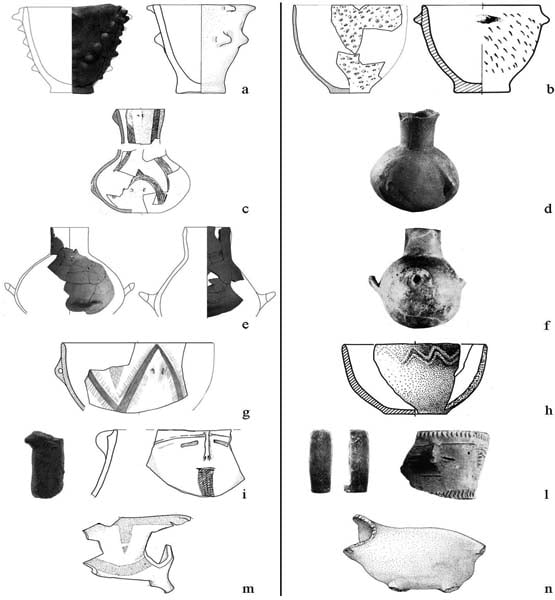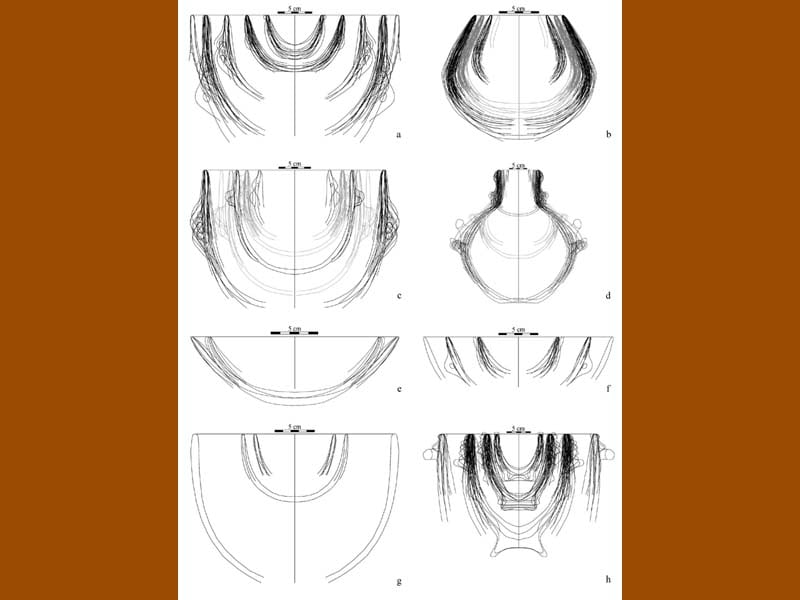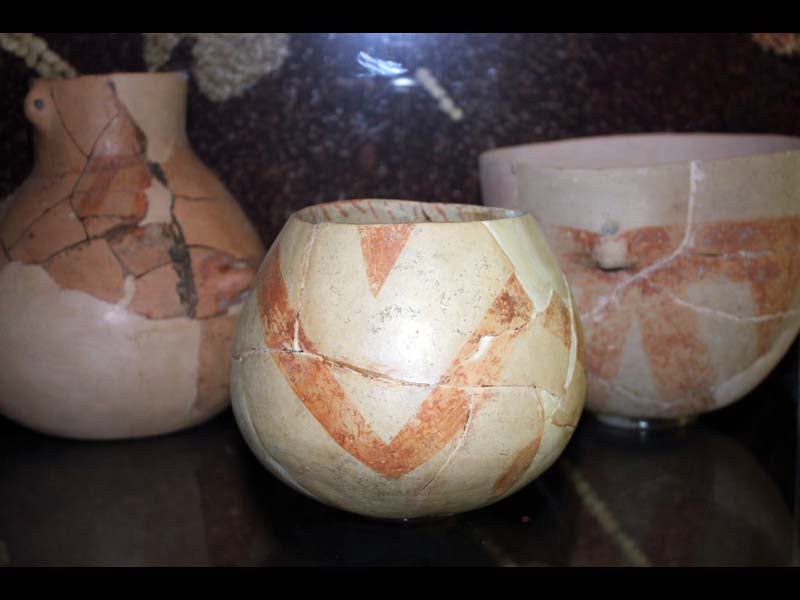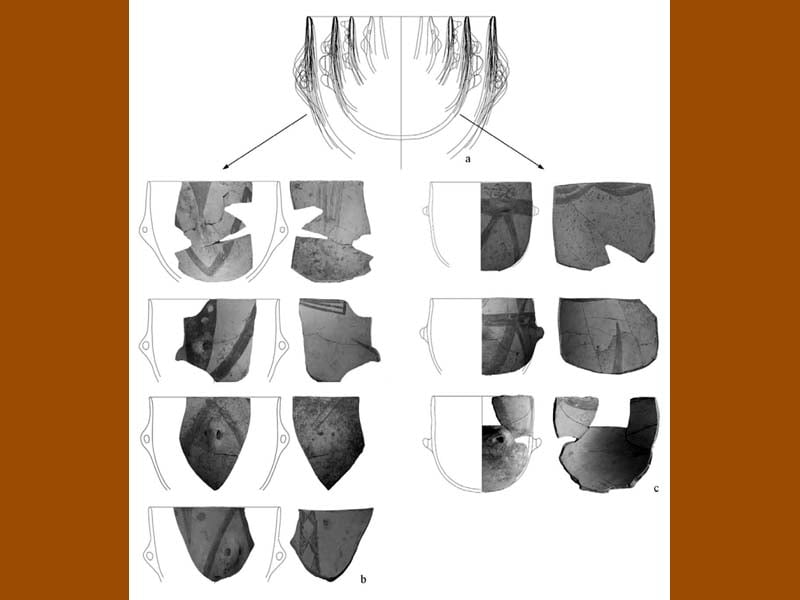di Giusi Di Crescenzo
The beginning of the Neolithic in the mid-Adriatic area coincides with the most advanced phase of the Early Neolithic in southern Italy.
"… The so-called "Neolithic package", which reaches southern Italy around 8000 years from today, seems to manifest itself with a slight chronological gap in the middle-Adriatic area, constantly placing itself between 5800 and 5200 cal BC (Skeates and Whitehouse 1995-1996 ) …” (in Marta Colombo and Carlo Tozzi, 2013).
In Abruzzo "… the Culture of Impressed Ceramics is flanked and followed by the Culture of Catignano, which fully falls within the “red band facies” (or bichrome ceramics) characteristic of southern Italy …” (in Marta Colombo and Carlo Tozzi, 2013).
"... the analysis of the sites characterized by the presence of "two-colour ceramics" shows how the phenomenon of the ceramic figulina decorated with red bands constitutes a unifying element for the vast territory that affects the entire Adriatic side, from Abruzzo to Puglia, and reaches the Matera area , in Calabria, Sicily and the Aeolian Islands …” (in Marta Colombo, 2010).
But this vast area can be divided into three minor areas including precisely the culture of Catignano.
"… On the basis of comparisons and radiometric datings it is now clear how the Culture of Catignano arises from the reworking of two main cultural influences that are at least partly contemporary: on the one hand the tradition of Middle-Adriatic Impressed Ceramics, on the other the ceramic figurine complexes painted of the southeast of the Peninsula …” (in Marta Colombo, 2010).

Again thanks to the radiometric dating available for the ceramics - found in the site of the same name, in Colle Cera, in the Grotta dei Piccioni and in the Grotta Sant'Angelo - the Catignano culture is precisely located between the levels of impressed ceramics and those of the Ripoli culture .
Relations with imprinted pottery are testified by the numerous fragments of coarse pottery from the two sites of Catignano and Colle Cera and belong to the first phase of development of the Catignano culture.
The substantial homogeneity in the production of vases is the unifying element of the entire area of the culture of Catignano:
"… the fact that they were produced with a certain shape, using a precise type of dough and above all with standardized dimensions seems to indicate the presence of a model shared by all the peoples of the Culture of Catignano to respond to precise social norms … It is therefore probable that the tendency of vessel dimensions to concentrate within dimensional classes reflects the effective existence of culturally standardized "metric categories"; the existence of a "metrological system", recently recognized also in the sphere of Bell-Beaker Culture, could even imply a standardized system of exchanges (Dzbynski, 2006 ...” (in Marta Colombo, 2013).

Not only the dimensions but also the decorations had to have a symbolic value which, however, no one has yet managed to decode: a language that served to communicate, within the groups, meanings perhaps on the use and volume of the objects and perhaps their own diversity to people outside the group, or as Vincent Georges had also highlighted, certain typical decorations helped to "calculate" the quantity of content with a simple glance.
In short, the objects produced and decorated not only had a utility function but the different types of decorations also had to serve to communicate something according to a grammar that is still mostly obscure.
In the most recent history of archeology, the merit certainly goes to Marija Gimbutas for having been the first to reconstruct, thanks to an enormous work of observation, some "grammars" of the prehistory of Old Europe to the point of even defining a "Language": that of "Goddess".
One of the most recurring decorative elements in Catignano ceramics is the zig-zag motif that Gimbutas indicated as an image of water and which is one of the oldest symbolic motifs documented in the prehistory of our planet.
On the other hand, different considerations are made with regard to the internal decorations of the open forms, which do not seem to follow predefined patterns and therefore leave room for the creativity of the artisan or craftsman.
Continuing with the description of the ceramics of the Catignano culture, it must still be emphasized that "… all the vase production of the settlements of Catignano and Colle Cera implies a very high level of practice, experience and know-how, probably the heritage not of the whole community indifferently, but of a few specialized individuals who, through regular production over time, could maintain and improve the quality of the products…"
An individual who was probably of the female gender given that – according to the opinion of academic archeology – the permanence necessary for craft activities was more than women due to physiological issues related to childbirth and menstruation.
But we can also introduce other points of view, such as that of the anthropologist Elisabeth Fisher in her text Women's Creation: Sexual Evolution and the Shaping of Society who argues that "… the first cultural device was probably a container …” and the containers were mainly used by women who were mostly gatherers and therefore needed containers in which to store the surplus crop to be consumed in moments following the harvest or to be exchanged with other individuals of the same community.
The most numerous finds are those in croma figulina ceramic or with red geometric motifs. A feature that appears occasionally is the black margin obtained with the negative technique (its first appearance is in the Scalaria cave).
Some fragments have bands and lines made with sharp tools on still fresh dough. And then there is the coarse ceramic which is not decorated but has plastic elements which mark the surface of the vase in geometric shapes.
In the Culture of Catignano the most numerous forms are the deep open forms, the closed forms without the neck and the flask vases, less present are the open and shallow forms.
"...almost all the vases are characterized by the presence of ribbon handles, an element which is instead almost absent in all the southern groups; although these have a very simple morphology, they refer directly to the characteristic handles of the impressed pottery ... In general it is difficult to provide a functional interpretation of the typologies of the different containers, but it is probable that both the deep vessels of open form and those of closed form and neckless were used for short-term storage and the "daily" consumption of small quantities of food ... these shapes have no closure elements and some experimental tests exclude that they were used to contain liquids: only the ceramic vases figulin manage to maintain their water content even for a few days, while the fine and coarse ceramic vessels were found to be completely permeable and rapidly dispersed their contents ...” (in Marta Colombo, 2013).
The Culture of Catignano corresponds as an era to the culture of Danilo on the eastern shore of the Adriatic and the exchanges between the two cultures have been repeatedly underlined by various scholars, nevertheless "… the birth and rapid diffusion of the red painting of the figulina pottery seem in all probability linked to a local development within the first southern painted pottery and not to external influences, in particular from the eastern Adriatic …” (in Marta Colombo and Carlo Tozzi, 2013).
Giusi Di Crescenzo, 2022
REFERENCES
- Giovanna Radi and Carlo Tozzi – “Imprinted ceramics and the culture of Catignano in Abruzzo” – in De Méditerranée et D'Ailleurs… Mélanges offerts à Jean Guilaine – Toulouse 2009;
- Marta Colombo and Carlo Tozzi – “The Culture of Catignano in the panorama of Italian neolithic painted pottery: contacts with the cultures of the eastern Adriatic shore” – in Studies in Mediterranean Archeology for Mario Benzi – Oxford 2013;
- Marta Colombo – “New data on the culture of Catignano: ideas and problems on its classification in the context of ceramics painted with red bands” – in Origini – XXXII – New Series IV – 2010;
- Marta Colombo – “Standardization of the measurements and decorations of the vases in the Culture of Catignano (5400/4900 cal BC): the presence of "units of measurement" in the Italian Neolithic” – in Acts of the XNUMXst International Congress on Estudios Ceramicos – University of Cadiz 2013;
- Alexander Dzbinsky – “Articles online. Un nouveau phénomène métrologique dans l'Europe néolitique” – in Bulletin de la Société prehistorique française volume 103 no. 1 – 2006 – pp. 160-169;
- Elizabeth A. Fisher – Women's Creation: Sexual Evolution and the Shaping of Society – Wildwood House Ltd – 1980;
- Tommaso Di Fraia and Daniela Tiberio – “New data from the Grotta Sant'Angelo in Civitella del Tronto (Te): which cults and/or which activities?” – in Prehistory and Protohistory in Etruria. Eighth meeting of Studies. Real landscapes and mental landscapes. Searches and excavations – 2006 – p. 477-489;
- Georges Vincent – “La volumemétrie dans les agrosystèmes prehistoriques: céramique étalon (bell-shaped) or instrument de mesure complexe? The ceramic container and the bell-shaped model” – in Bulletin de la Société prehistorique française volume 103 no. 3 - 2006 - p. 609 - 613.



